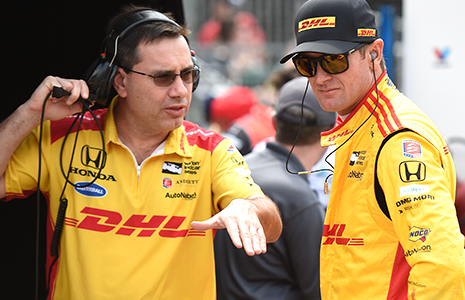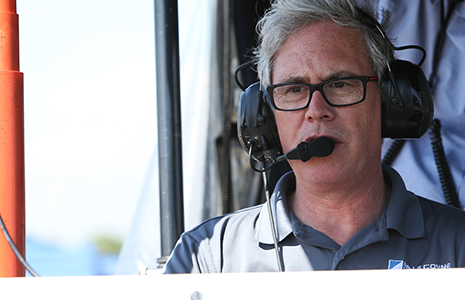Ray Gosselin has been the engineer for Ryan Hunter-Reay at Andretti Autosport since 2010, but he still pays close attention to how the chemistry works with other drivers and engineers in the Verizon IndyCar Series.
“You might pick up on something in the way they interact,” Gosselin said. “What we’ve done has evolved over time. What helped us is we had some good success right out of the gate.”
Series drivers and engineers agree that immediate results are key for establishing trust and confidence. Gosselin and Hunter-Reay still rely on what they learned together in the beginning. Hunter-Reay finished seventh in the points for two years, then won a series title in 2012.
 “It doesn’t take long when you start making headway,” said Hunter-Reay, who finished fourth in the points this season – his best result since winning the championship six years ago. “Things are marching in the right direction, you’re speaking the same language and you get results. It all falls into place.”
“It doesn’t take long when you start making headway,” said Hunter-Reay, who finished fourth in the points this season – his best result since winning the championship six years ago. “Things are marching in the right direction, you’re speaking the same language and you get results. It all falls into place.”
That said, Hunter-Reay admits he can be “pretty passionate” when communicating. Gosselin typically stays “chill” and reassures they can still succeed. Gosselin traces their productive connection to the driver’s first test at Sebring in December 2009.
“It translated right away,” Gosselin said. “We were second in our first race and won three races later at Long Beach. Having that success, we were able to get into a rhythm that works, things I thought we should be doing and what he thought we should be doing. A lot of things we do today is still the same as we did that first time.”
It doesn’t always work that way. While four-time Indy car champion Sebastien Bourdais enjoys a lengthy successful history with engineers Craig Hampson and Olivier Boisson, the Frenchman admits that chemistry hasn’t always been there with other engineers.
“It can be quite instantaneous,” Bourdais said. “It can take longer. And it can never happen. Sometimes it’s just personalities that don’t mesh.”
He first worked with Hampson in 2003 with Newman/Haas Racing. They celebrated four consecutive Champ Car World Series titles. His relationship with Boisson started in 2014 when they were with KV Racing Technology. The trio have been working together at Dale Coyne Racing with Vasser-Sullivan since 2017.
“Craig and I are very competitive and we don’t do very well with mediocre moments,” Bourdais said. “Craig is fire and I’m fire sometimes, too.”
Boisson, a fellow Frenchman, adds a more even-keel component.
“We all have a role to play,” Boisson said. “I’m just looking at the data and Craig and Seb talk it out. Drivers sometimes when they come out of the car, they have emotions. I look at the data to sort it out.
“Seb is the kind of guy who is always going to push for more because that’s how we can get those other (competitors). Racing is also about the human aspect. When you have the good chemistry between Seb, Craig and I, we can make good things happen. We don’t have the resources of the (super teams), but Seb is so good at feedback, it makes your life easy. And the chemistry Craig and I have with him, it makes things a lot simpler.”
 Hampson admits he’s “wrapped pretty tight” and alludes to how everything can constantly change in an evolving series environment.
Hampson admits he’s “wrapped pretty tight” and alludes to how everything can constantly change in an evolving series environment.
“If you’re successful, that trust comes,” he said. “If you struggle, that trust doesn’t come or it goes away. Like any very close relationship, you do have to really work at it. You do need to communicate. You shouldn’t just let things fester if you feel like you’re struggling or you’re not on the same page. You need to talk about it.
“We know what we’re up against, fighting against a Penske, Ganassi or an Andretti. We’re fighting the good fight and putting on a pretty good display.”
Bourdais, who ranked seventh in the final point standings this season, has won the season-opening Firestone Grand Prix of St. Petersburg each of the past two years. His 37 career wins rank sixth on the career list.
“As soon as you’re off a little bit,” Bourdais said of the competitive series, “you’re not top five, you’re 15th.”
One of the more recent relationships to develop has been between Andretti Autosport driver Alexander Rossi and engineer Jeremy Milless. They agree that it took about three months working together in 2017 to get in sync.
Rossi won three races this year and finished second to Scott Dixon in the championship.
“I don’t think we’re far away from where we need to be,” Rossi said of working with Milless as well as race strategist Rob Edwards. “I don’t think we’re far away from where Ryan and Ray are. They’ve been together so long and have an effective working relationship.
“Jeremy and I are both pretty quiet. We do a lot of our discussions at the shop and at the track. If we’re struggling on a particular evening, yeah, we’ll talk until midnight. At Road America on Friday this year, we had really struggled, we were like 12th in practice. As more information came and we got more data and went back to the hotel, we bounced ideas off each other. We came out and were quickest through the first two rounds of qualifying and qualified fifth. There’s a time and place for that.
“At the same time, there’s a lot to be said for sleeping on it and not over-thinking it and seeing what you come up with in the morning. That’s our nature. It’s Rob Edwards’ nature, too. We’re three very even-keel guys.”
Milless acknowledges he tries to stay calm when the competitive juices are flowing.
“I keep it inside,” he said. “I pound my fist a lot. I won’t go on the radio and say anything to him.”
He smiles and adds, “I don’t get yelled at as much as Ray does.”
 Dale Coyne Racing engineer Michael Cannon has one of the lengthiest histories of working with Indy car drivers, dating to being an assistant engineer with Patrick Carpentier in 1998. The list of drivers he’s worked with includes Alex Tagliani, Paul Tracy, Tony Kanaan, AJ Allmendinger, Buddy Rice and Ed Jones. This year, he handled rookies Pietro Fittipaldi, Zachary Claman De Melo and Santino Ferrucci.
Dale Coyne Racing engineer Michael Cannon has one of the lengthiest histories of working with Indy car drivers, dating to being an assistant engineer with Patrick Carpentier in 1998. The list of drivers he’s worked with includes Alex Tagliani, Paul Tracy, Tony Kanaan, AJ Allmendinger, Buddy Rice and Ed Jones. This year, he handled rookies Pietro Fittipaldi, Zachary Claman De Melo and Santino Ferrucci.
“It’s a two-way street,” Cannon said. “You start working with somebody and you start building in confidence in them and vice-versa. You know pretty quickly if the guy has the goods or not.
“With the younger drivers coming into the series, you try to educate them as much as you can about some of the ins and outs of the actual race car, what an Indy car will do and what an Indy car won’t do.
“You can’t drive it like a 2-liter Mazda or an Indy Lights car. These cars have some habits and you have to work with them. It doesn’t take them long to understand this tiny little box we have to live in with the car. I go in with an open mind. I have a lot of faith in the drivers. We work collaboratively. I’m not here to dictate to them.”
Cannon says he doesn’t get “ruffled” when racing gets intense. That’s when it’s even more important to keep the ears tuned to what he’s hearing.
“You’ve just got to keep an open mind and really listen to the driver,” he said. “My job is to present a race car that’s somewhere in the ballpark. I present this car to them. This is the car we think is suitable for this track. Drive it and tell me if I’m right or wrong. That’s what they do. They tell me it does this and it does that. Then we make adjustments to try to improve it. As you improve the car, the driver’s trust builds in you.”